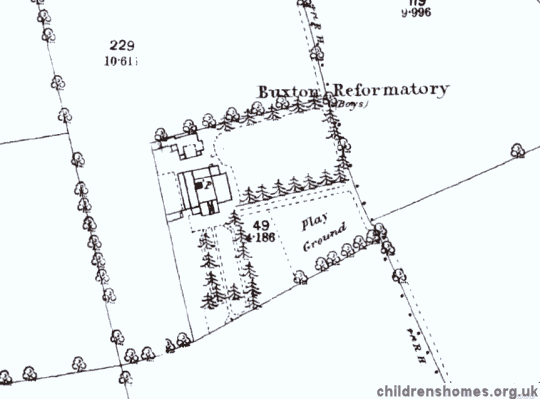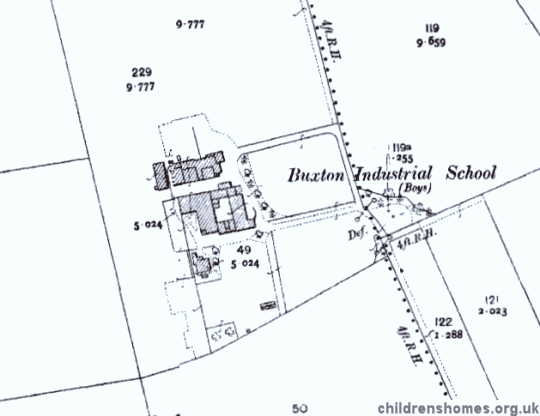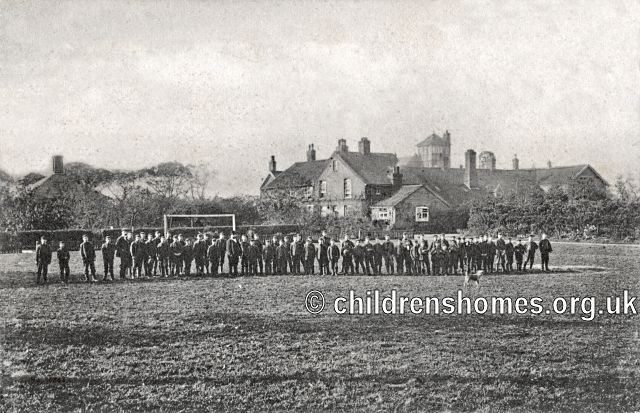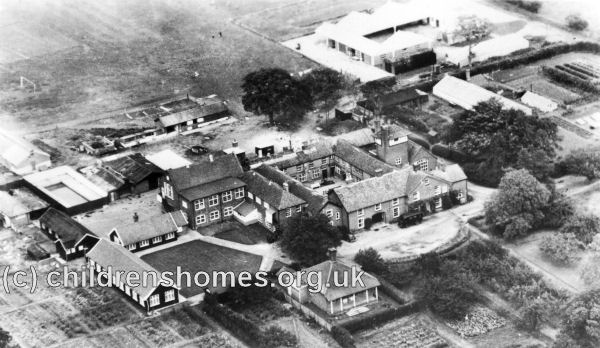Buxton Reformatory / Industrial / Approved School for Boys, Norwich, Norfolk
At a meeting of the County magistrates in 1852 it was agreed that an establishment should be formed for the maintenance and religious and industrial training of forty lads under the age of twenty. The following year, the Buxton Reformatory for Boys was established by John Wright in collaboration with John Henry Gurney, George Kett and Sir Edward North Buxton M.P., for the voluntary reformation of boys or young men who had previously been confined in Norwich Castle. On July 7th, 1855, the establishment, situated at Buxton Lamas (now Buxton with Lamas, or sometimes Lammas) in the parish of Marsham, was officially certified under the 1854 Reformatory School Act to accommodate up to 40 boys.
The red-brick School buildings were constructed around a quadrangle, the first example of this design which became a common layout for such institutions. An early report described the premises as "plain, but thoroughly substantial, well ventilated, and conveniently arranged." Mr Wright to an active part in the superintendence and scriptural instruction. The industrial training comprised farm work and shoemaking.
In 1857, a shortage of accommodation at the School led to the opening of a smaller satellite establishment at Catton, near Norwich, which was referred to as the Norfolk Reformatory. A decline in admissions to the main School led to the closure of Catton in 1859. In 1862, the number of boys at Buxton had sunk to 23, but gradually increased over the following years.
The School site is shown on the 1886 map below.

Buxton Reformatory for Boys site, Norfolk, c.1886.
The industrial training at the School was chiefly working its own own farmland, which by 1873 had been increased to 40 acres, and that of neighbouring farms. There was also a class in shoemaking. In 1870, Mr Wright rigged up two masts at the School so that the boys could be taught naval exercises. He died the following year.
Following a steady decline in reformatory committals, Buxton was re-certified as an Industrial School on June 23rd, 1894. Mr and Mrs Thomas Babington (or Babbington) continued in post as superintendent and matron, a position they had held since 1863. Their, Tom, was now schoolmaster and assistant superintendent. In October, 1897, following the death of his father, Tom and his wife were appointed superintendent and matron. In June 1898, Tom's younger brother Alfred and his wife took over the posts.
In 1896, the School was described as "old fashioned, and in many respects below modern requirements. The accommodation is cramped, i.e. 1 room has to serve for meals, school, and recreation." At that date, the farm extended to 51 acres, with a considerable amount of stock, including pigs and poultry. Industrial training had now expanded to include bread making and tailoring. There was twice-weekly physical drill and once a week in the summer the boys bathed in the nearby River Bure. Occasional treats included picnics and trips to the seaside. In the winter, concerts and various forms of entertainment were organised, including readings by the superintendent. The School had its own library.
In response to the repeated criticism of the School's premises, a new school room, workshop, play shed and dormitory were erected in 1899 and 1900; an infirmary was added in 1903, and a swimming bath in 1904. On September 5th, 1900, the School was re-certified to accommodate 90 boys, aged from 10 upwards. The School site in around 1908 is shown on the map below.

Buxton Industrial School for Boys site, Norfolk, c.1908.

Buxton Industrial School for Boys, from the south-east, c.1905. © Peter Higginbotham
In the 1920s, the establishment became known as the Red House Farm School. In 1933, Red House became an Approved School, one of the new institutions introduced by the 1933 Children and Young Persons Act to replace the existing system of Reformatories and Industrial Schools. It accommodated up to 108 Intermediate Boys aged between their 13th and 15th birthdays at their time of admission. The industrial training at the School was largely confined to farming and gardening. Later additions to the buildings are shown in the picture below.

Red House Farm School, Buxton, aerial view from the south-west. © Peter Higginbotham

Red House Farm School, Buxton, aerial view from the south-west. © Peter Higginbotham
In 1973, the School became a Controlled Community Home with Education (CHE) under the control of Norfolk County Council. The School closed in July 1981 and the site and buildings reverted to the School's original owners, now known as the Red House School Foundation, which then sold them off in various plots. In 1984, the main buildings were purchased by the Tvind School Co-operative of Denmark. This body set up a school for deprived and disturbed children and adolescents known as The Small School at Red House, to which Local Education Authorities from all over the country sent individuals.
In 1992, the Foundation used the proceeds from the sale of the property to establish the Red House School Charitable Trust. Its objects were to further the education and training of child who had been in County Council care, or any child or young person in need. In 2002, Red House combined with Norfolk Youth Projects to form Red House Youth projects.
The Red House buildings no longer survive and Rowan House Hospital now occupies the site.
Records
Note: many repositories impose a closure period of up to 100 years for records identifying individuals. Before travelling a long distance, always check that the records you want to consult will be available.
- Norfolk Record Office, The Archive Centre, Martineau Lane, Norwich NR1 2DQ. Has "Administrative papers" (1853-1995); Architectural/building plans.
Bibliography
- Mellor, Derick A History of the Red House Farm School, Buxton near Norwich (1976)
- Carpenter, Mary Reformatory Schools, for the Children of the Perishing and Dangerous Classes, and for Juvenile Offenders (1851, General Books; various reprints available)
- Carlebach, Julius Caring for Children in Trouble (1970, Routledge & Kegan Paul)
- Higginbotham, Peter Children's Homes: A History of Institutional Care for Britain's Young (2017, Pen & Sword)
- Abel Smith, Doroth Crouchfield: A History of the Herts Training School 1857-1982 (2008, Able Publishing)
- Garnett, Emmeline Juvenile offenders in Victorian Lancashire: W J Garnnett and the Bleasdale Reformatory (2008, Regional Heritage Centre, Lancaster University)
- Hicks, J.D. The Yorkshire Catholic Reformatory, Market Weighton (1996, East Yorkshire Local History Society)
- Slocombe, Ivor Wiltshire Reformatory for Boys, Warminster, 1856-1924 (2005, Hobnob Press)
- Duckworth, J.S. The Hardwicke Reformatory School, Gloucestershire (in Transactions of the Bristol and Gloucestershire Archaeological Society, 1995, Vol. 113, 151-165)
- Higginbotham, Peter Children's Homes: A History of Institutional Care for Britain's Young (2017, Pen & Sword)
- Mahood, Linda Policing Gender, Class and Family: Britain, 1850-1940 (1995, Univeristy of Alberta Press)
- Prahms, Wendy Newcastle Ragged and Industrial School (2006, The History Press)
- Higginbotham, Peter Children's Homes: A History of Institutional Care for Britain's Young (2017, Pen & Sword)
- Hyland,Jim Yesterday's Answers: Yesterday's Answers: Development and Decline of Schools for Young Offenders (1993, Whiting and Birch)
- Millham, S, Bullock, R, and Cherrett, P After Grace — Teeth: a comparative study of the residential experience of boys in Approved Schools (1975, Chaucer Publishing)
Links
- Red House Youth projects
- Red Lodge Museum, Bristol — a former girls' reformatory.
- None noted at present.
Except where indicated, this page () © Peter Higginbotham. Contents may not be reproduced without permission.


